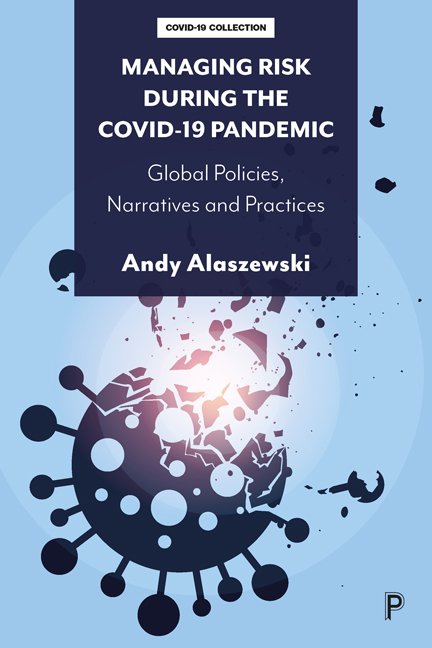Book contents
- Frontmatter
- Dedication
- Contents
- List of tables
- List of abbreviations
- About the author
- Acknowledgements
- Foreword
- Preface
- 1 Introduction: risk as a key feature of late modern societies
- PART I Responding to the challenges of the pandemic
- PART II Mitigating risk through science and technology
- PART III Risk narratives
- References
- Index
7 - Pandemic narratives: telling stories about COVID-19 and its risks
Published online by Cambridge University Press: 20 January 2024
- Frontmatter
- Dedication
- Contents
- List of tables
- List of abbreviations
- About the author
- Acknowledgements
- Foreword
- Preface
- 1 Introduction: risk as a key feature of late modern societies
- PART I Responding to the challenges of the pandemic
- PART II Mitigating risk through science and technology
- PART III Risk narratives
- References
- Index
Summary
Pandemic narratives and risk
The media and representations of risk
As Giddens (1999) has observed, a key feature of modernity is the development of new and multiple forms of communication, enabling information to move more rapidly over greater distances. In the 20th century, the well-established print media have been complemented by new modes of communication. Some of these such as televisions and radio broadcasting replicate the structures of the print media. Others such as social media provide new modes that are based on more open access and less scrutiny of the material published.
With the development of different modes of communication, individuals can access information from a range of sources. In modern global societies, events happening in distant places can affect our lives in unexpected ways and we gain knowledge about such events from various media (Giddens, 1999). Such rapid and open communication was evident in the COVID-19 pandemic. The physical spread of the virus was preceded by the spread of information online. On 30 December 2019, the head of the Emergency Department in Wuhan Dental Hospital received a test result carried out by a lab in Beijing marked ‘SARS CORONAVIRUS’. She highlighted it in red and passed it to the Chinese messaging site WeChat, which posted it online. This posting was picked up by a local doctor, Li Wenliang, who shared the posting with his university class group, and it rapidly spread. When the local health commission issued orders for local hospitals to report cases to it and not to discuss such cases in public, these orders were leaked online. Dr Marjorie Pollack, deputy editor of ProMed, a programme monitoring the internet for information about disease outbreaks, was alerted to this chatter by a contact in Taiwan. Pollack issued an emergency post on the ProMed network asking for more information, and received notification of a posting on a Chinese business news site confirming early reports. She also received an alert from an artificial intelligence system at Boston's Children Hospital about pneumonia cases in Wuhan. On the basis of this evidence, Pollack issued a warning just before midnight on 31 December 2019, to the ProMed global community, 80,000 doctors, epidemiologists and public health experts, about a new SARS-like disease in Wuhan (McMullen, 2020; Honigsbaum, 2020, pp 261– 2).
- Type
- Chapter
- Information
- Managing Risk during the COVID-19 PandemicGlobal Policies, Narratives and Practices, pp. 103 - 116Publisher: Bristol University PressPrint publication year: 2023



